Battery Cable Negative
Removal Procedure
Whenever battery cables are replaced, always be certain to use a replacement battery cable that is the same type and length. Some positive cables have additional feed wires attached to them and some negative cables have additional ground straps attached. Always be certain when replacing a battery cable to route it the same as the one being replaced.
- Remove the negative battery cable from the negative battery terminal. Refer
to
Caution: Unless directed otherwise, the ignition and start switch must be in the OFF or LOCK position, and all electrical loads must be OFF before servicing any electrical component. Disconnect the negative battery cable to prevent an electrical spark should a tool or equipment come in contact with an exposed electrical terminal. Failure to follow these precautions may result in personal injury and/or damage to the vehicle or its components.
in General Information. - Remove the negative cable ground bolt and the negative cable ground washer.
- Remove the ground strap.
- Remove the generator. Refer to Generator Replacement .
- Remove the nut, washer, and cable from the bolt.
- Remove any clamps or retainers securing the negative cable to the body.
- Remove the negative cable from the vehicle.
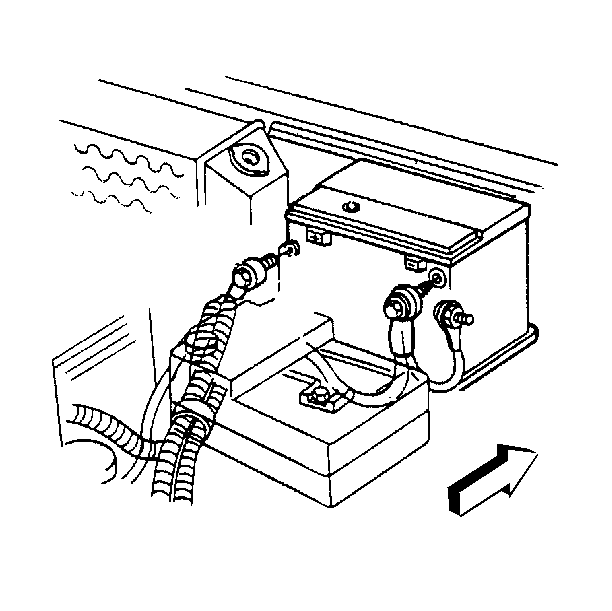

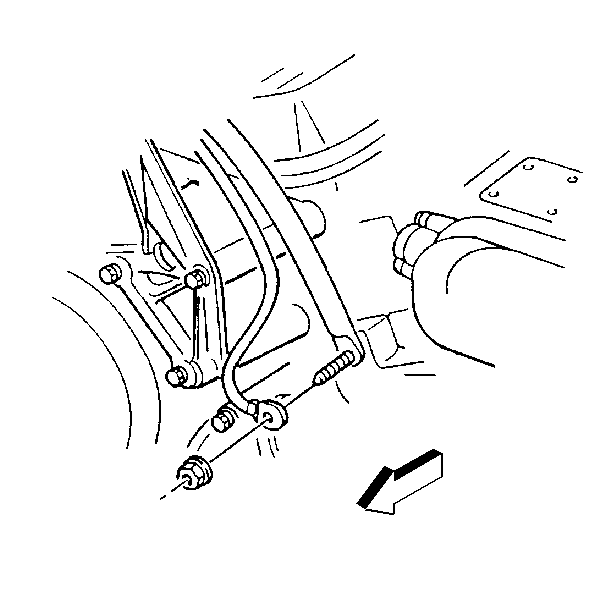
| • | Note the routing. |
| • | Route as noted during the removal. |
Installation Procedure
- Install the negative battery cable to the vehicle.
- Install any clamps or retainers securing the negative cable to the body.
- Install the negative cable, washer and nut to the bolt.
- Install the generator. Refer to Generator Replacement .
- Install the ground strap.
- Install the negative cable ground bolt and the negative cable ground washer.
- Install the negative battery cable to the negative battery terminal.
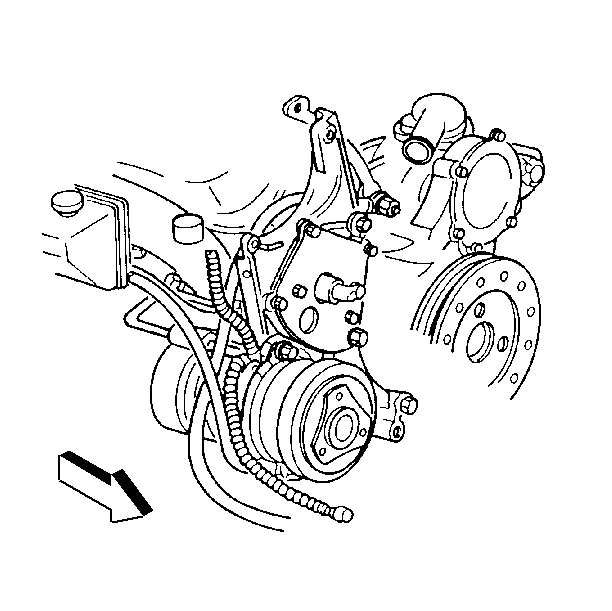
Important: Route the negative battery cable over and through the generator support bracket.

Tighten
Tighten the nut to 34 N·m (25 lb ft).
Notice: Use the correct fastener in the correct location. Replacement fasteners must be the correct part number for that application. Fasteners requiring replacement or fasteners requiring the use of thread locking compound or sealant are identified in the service procedure. Do not use paints, lubricants, or corrosion inhibitors on fasteners or fastener joint surfaces unless specified. These coatings affect fastener torque and joint clamping force and may damage the fastener. Use the correct tightening sequence and specifications when installing fasteners in order to avoid damage to parts and systems.

Tighten
Tighten the negative cable ground bolt to 4 N·m (35 lb in).
Tighten
Tighten the negative battery cable to 17 N·m (13 lb ft).
Battery Cable Positive
Removal Procedure
Whenever battery cables are replaced, always be certain to use a replacement battery cable that is the same type and length. Some positive cables have additional feed wires attached to them and some negative cables have additional ground straps attached. Always be certain when replacing a battery cable to route it the same as the one being replaced.
- Disconnect the negative battery cable from negative battery terminal.
Refer to
Caution: Unless directed otherwise, the ignition and start switch must be in the OFF or LOCK position, and all electrical loads must be OFF before servicing any electrical component. Disconnect the negative battery cable to prevent an electrical spark should a tool or equipment come in contact with an exposed electrical terminal. Failure to follow these precautions may result in personal injury and/or damage to the vehicle or its components.
in General Information. - Disconnect the positive battery cable from the positive battery terminal.
- Remove the generator lead nut from the generator.
- Remove the positive battery cable bolt.
- Disconnect the positive battery cable nuts from the starter solenoid switch and electrical center.
- Disconnect the positive battery cable from the starter solenoid switch and the electrical center.

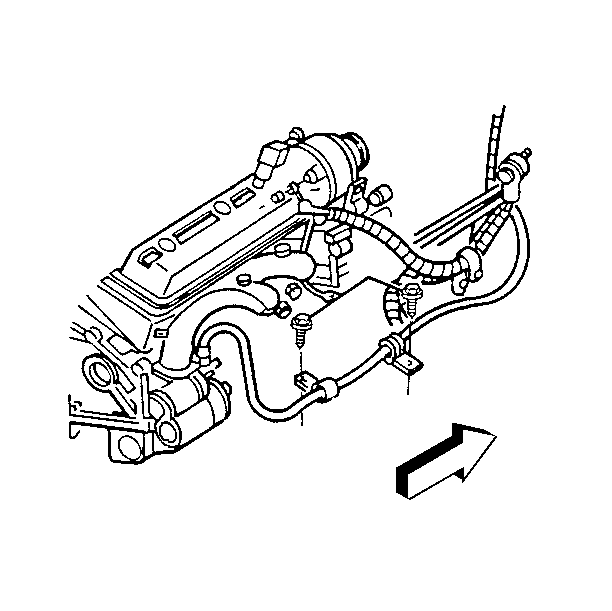
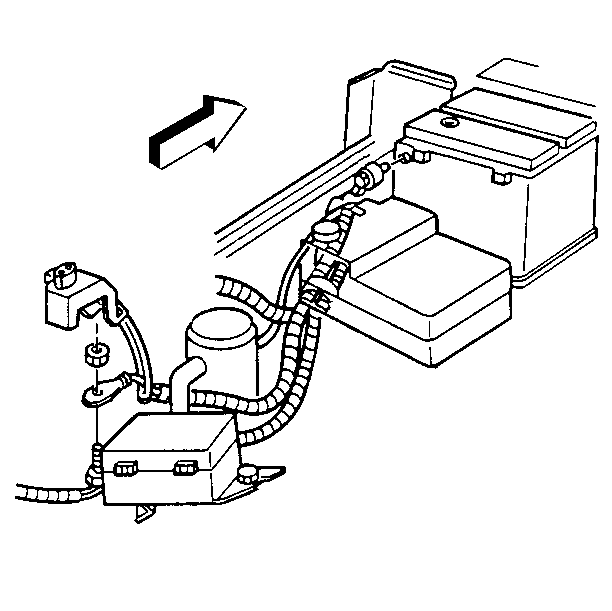
Installation Procedure
- Tighten the solenoid battery terminal nut.
- Connect the positive battery cable to the starter solenoid switch.
- Connect the positive battery cable to the electrical center.
- Connect the positive cable to the generator.
- Install the generator lead nut.
- Install the positive battery cable to the frame.
- Connect the positive battery cable to the battery positive terminal.
- Connect the negative battery cable to the battery negative terminal.

Notice: Before attaching the field lead, be sure that the starter solenoid terminal is secure by tightening the nut next to the cap. This only applies to SD-260 and PG-250 starter motors. If this nut is not tight, the cap may be damaged during installation of the field lead and cause the starter to fail later.
Tighten
Tighten the solenoid battery terminal nut to 10 N·m (89 lb in).
Notice: Use the correct fastener in the correct location. Replacement fasteners must be the correct part number for that application. Fasteners requiring replacement or fasteners requiring the use of thread locking compound or sealant are identified in the service procedure. Do not use paints, lubricants, or corrosion inhibitors on fasteners or fastener joint surfaces unless specified. These coatings affect fastener torque and joint clamping force and may damage the fastener. Use the correct tightening sequence and specifications when installing fasteners in order to avoid damage to parts and systems.

Tighten
Tighten the positive cable nut to 10 N·m (89 lb in).
Tighten
Tighten the positive cable nut to 10 N·m (89 lb in).
Tighten
Tighten the generator lead nut 13 N·m (115 lb in).

Tighten
Tighten the positive battery cable bolts to 4.8 N·m (42 lb in).

Tighten
Tighten the positive battery cable bolt to 17 N·m (13 lb ft).
Tighten
Tighten the positive battery cable bolt to 17 N·m
(13 lb ft).
